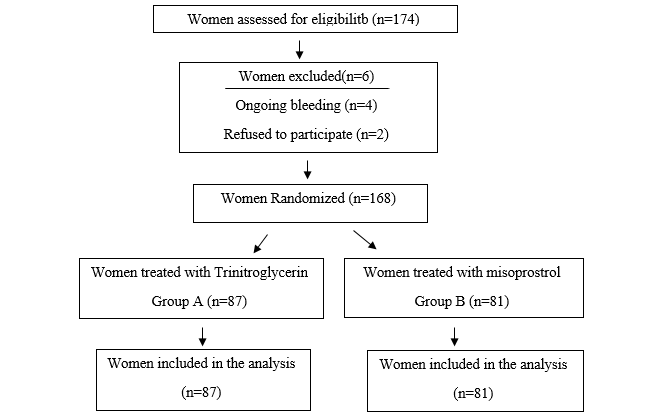Cervical ripening before surgical evacuation of first-trimester pregnancy: a comparison between misoprostol and trinitroglycerin
Keywords:
Misoprostol, Trinitroglycerin, Cervical ripeningAbstract
Introduction: Termination of pregnancy through curettage in the first trimester requires cervical ripening (CR) which can be induced by medicinal or mechanical methods. In the pharmaceutical method, vaginal administration of misoprostol, as well as vaginal trinitroglycerin (TNG), has been shown to induce effective CR. This study was conducted with the aim of comparing vaginal misoprostol and vaginal TNG in the CR of women candidates for the first-trimester curettage.
Materials and Methods: This double-blind clinical trial study was conducted on 168 pregnant women with a gestational age of less than 14 weeks who were candidates for curettage. Participants were randomly divided into two groups receiving vaginally either TNG (400 µgr)(n=87) or misoprostol (400 µgr) (n=81). Then, the state of CR and the need for mechanical dilatation were compared between the two groups. Also, the presence of any side effects caused by drug use was determined.
Results: The percentage of CR in the misoprostol group (67.9%) was significantly higher than in the TNG group (32.2%) (P<0.001). Therefore, the need for mechanical dilatation in the TNG group (66.7%) was significantly higher compared with the misoprostol group (32.1%) (P<0.001). Also, the rate of complications like diarrhea (9.9%) and abdominal pain (7.4%) in the misoprostol group was significantly higher than in the TNG group (0%). However, headache in the TNG group (34.5%) was significantly higher than in the misoprostol group (0%) (P>0.001). Generally, the rate of complications in the TNG group (35.6%) was significantly higher compared with the misoprostol group (13.6%) (P>0.001).
Conclusion: Vaginally Misoprostol is more effective than vaginally TNG on CR of first-trimester curettage as well as it significantly reduces the need for mechanical dilatation of the cervix.

Additional Files
Published
How to Cite
License
Copyright (c) 2023 Fatemeh Hosseinzadeh, Mandana Mansour Ghanaie, Roya Faraji, Ghazaleh Ghorbani, Seyedeh Maryam Asgari Galebin, Sedigheh Pakseresht, Saman Maroufizadeh, Seyed Mohammad Asgari Galebin

This work is licensed under a Creative Commons Attribution-NonCommercial 4.0 International License.
